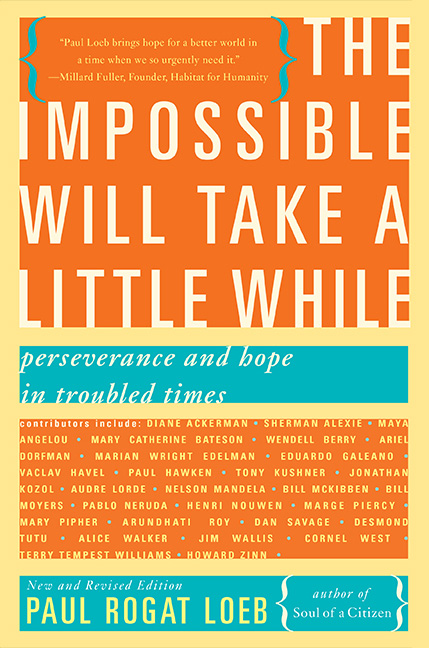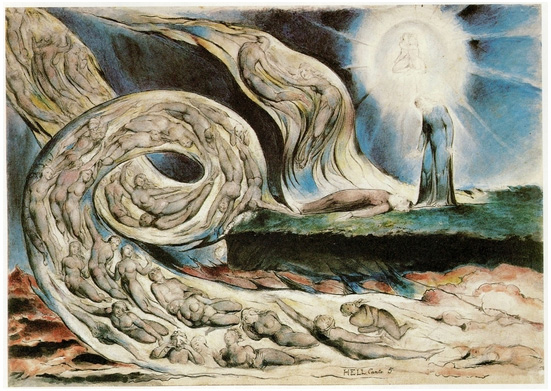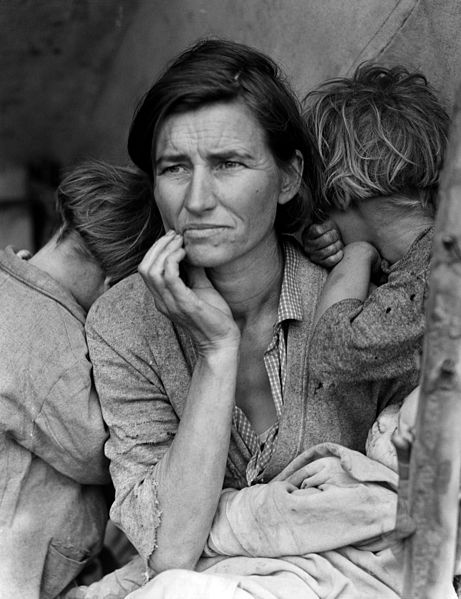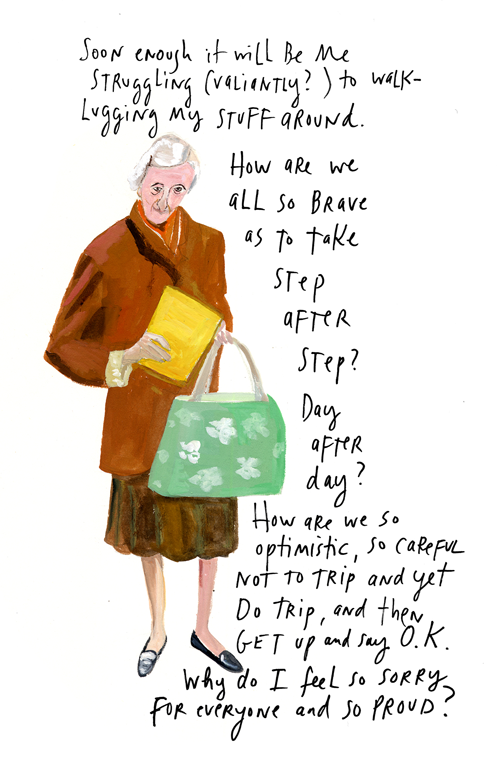What It Really Means to Live Our Mission
A beautiful meditation on how we learn to stand at the gates of hope in troubled times.
 “How are we so optimistic, so careful not to trip and yet do trip, and then get up and say OK?”Maira Kalman asked in pondering happiness and existence. What is it that propels us to get up after loss, after heartbreak, after failure? What is that immutable rope that pulls us out of our own depths — depths we hardly knowuntil that moment when the light of the surface vanishes completely and unreachably?
“How are we so optimistic, so careful not to trip and yet do trip, and then get up and say OK?”Maira Kalman asked in pondering happiness and existence. What is it that propels us to get up after loss, after heartbreak, after failure? What is that immutable rope that pulls us out of our own depths — depths we hardly knowuntil that moment when the light of the surface vanishes completely and unreachably?
That’s precisely what the Reverend Victoria Safford explores in a gorgeous essay titled“The Small Work in the Great Work” fromThe Impossible Will Take a Little While: Perseverance and Hope in Troubled Times(public library) — a soul-stretching collection of reflections by such luminaries as Pablo Neruda, Maya Angelou, Diane Ackerman, Alice Walker, Bill Moyers, and Nelson Mandela, edited by social activist Paul Loeb and titled after Billie Holiday’s famous song lyric, “The difficult I’ll do right now. The impossible will take a little while.”
Artwork by William Blake for Dante's 'Divine Comedy.' Click image for more.
Safford considers what motivated the men and women who marched in the first LGBT pride parades four decades ago — what beyond courage and imagination. In a beautiful sentiment that calls to mind Charles Bukowski’s poem about the irrepressible impulse that drives creative work, Safford channels what these visionary marchers might tell us:
Once you have glimpsed the world as it might be, as it ought to be, as it’s going to be (however that vision appears to you), it is impossible to live compliant and complacent anymore in the world as it is… And so you come out and walk out and march, the way a flower comes out and blooms, because it has no other calling. It has no other work.
[…]
I am interested in what Seamus Heaney calls the meeting point of hope and history, where what has happened is met by what we make of it. What has happened is met midstream by people who are — among the multitude of things we are — spiritual beings and all that that implies of creativity, imagination, crazy wisdom, ancient wisdom, passionate compassion, selfless courage, and radical reverence for life. And love—for one another absolutely, and that love that rises out of us, for something larger than ourselves, call it what you will. I am interested in the place, the places, where history is met by the hope of the human soul, life’s longing for itself. I am interested in hope on this side of the grave — for me there is no other kind — and in that tidal wave of justice that could rise up if only we would let it.
Dorothea Lange's 'Migrant Mother,' a photograph as iconic as its story is remarkable. Click image for details.
Reflecting on the “particular, precise disaster” of September 11 and how “silence made its holy way” among those bearing witness, Safford argues that this longing, this hope, is all the more piercing in such moments of unholy din. She illustrates this with a poignant anecdote:
I have a friend who traffics in words. She is not a minister, but a psychiatrist in the health clinic at a prestigious women’s college. We were sitting once not long after a student she had known, and counseled, committed suicide in the dormitory there. My friend, the doctor, the healer, held the loss very closely in those first few days, not unprofessionally, but deeply, fully — as you or I would have, had this been someone in our care.
At one point (with tears streaming down her face), she looked up in defiance (this is the only word for it) and spoke explicitly of her vocation, as if out of the ashes of that day she were renewing a vow or making a new covenant (and I think she was). She spoke explicitly of her vocation, and of yours and mine. She said, “You know I cannot save them. I am not here to save anybody or to save the world. All I can do — what I am called to do — is to plant myself at the gates of Hope. Sometimes they come in; sometimes they walk by. But I stand there every day and I call out till my lungs are sore with calling, and beckon and urge them in toward beautiful life and love…
There’s something for all of us there, I think. Whatever our vocation, we stand, beckoning and calling, singing and shouting, planted at the gates of Hope. This world and our people are beautiful and broken, and we are called to raise that up — to bear witness to the possibility of living with the dignity, bravery, and gladness that befits a human being. That may be what it is to “live our mission.”
That mission, of course, is different for each of us. We can’t — nor need we — all be psychiatrists reigning desperate souls in from the edge. In our age of “troubled times,” per the book’s title, so much of that fear and so little of that despairingly necessary hope is being mongered by the media — which calls to mind E.B. White’s urgently unforgettable assertion that a writer’s duty is “to lift people up, not lower them down.”
Artwork by Maira Kalman from 'The Principles of Uncertainty.' Click image for more.
Safford, that rare kind of writer who does the heavy lifting with immeasurable grace, considers what is required of us — what we owe ourselves and each other — in planting ourselves gently but unflinchingly in our mission:
We stand where we will stand, on little plots of ground, where we are maybe “called” to stand (though who knows what that means?) — in our congregations, classrooms, offices, factories, in fields of lettuces and apricots, in hospitals, in prisons (on both sides, at various times, of the gates), in streets, in community groups. And it is sacred ground if we would honor it, if we would bring to it a blessing of sacrifice and risk…
Our mission is to plant ourselves at the gates of Hope — not the prudent gates of Optimism, which are somewhat narrower; nor the stalwart, boring gates of Common Sense; nor the strident gates of Self-Righteousness, which creak on shrill and angry hinges (people cannot hear us there; they cannot pass through); nor the cheerful, flimsy garden gate of “Everything is gonna be all right.” But a different, sometimes lonely place, the place of truth-telling, about your own soul first of all and its condition, the place of resistance and defiance, the piece of ground from which you see the world both as it is and as it could be, as it will be; the place from which you glimpse not only struggle, but joy in the struggle. And we stand there, beckoning and calling, telling people what we are seeing, asking people what they see.
The remainder of The Impossible Will Take a Little While is just as vitalizing, just as tenderly tenacious at lighting that inner fire that warms us out of our complacency and cynicism, those virulent specters of contemporary culture which we, in a billion daily ways, choose to propagate or choose to eradicate.
This article originally appeared in Brain Pickings and is republished with permission. The author Maria Popova is a cultural curator and curious mind at large, who also writes for Wired UK, The Atlantic and Design Observer, and is the founder and editor in chief of Brain Pickings.
SHARE YOUR REFLECTION
2 Past Reflections


On Dec 15, 2014 Kristin Pedemonti wrote:
Thank you for this reminder. Thank you to everyone who is standing and speaking and marching and singing and saying their truth at the Gates of Hope. Here's to not giving up and to knowing that even if what we speak from our heart is making a difference to even one person, it is enough!
Hugs from my heart to yours.




On Dec 15, 2014 Ethan Glover wrote:
Wow, very moving stuff. Thanks for it.
----------------------------------------------------------
One Spirit One World
Post Your Reply